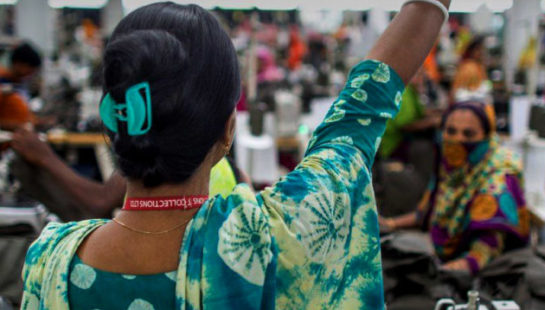To answer that question, we need to go back to the beginning, and look at how our clothes are made.
Our Research Investigates If Brands’ Sustainable Fibre Claims Stack Up
Most fabric is made from yarn, spun from fibres that are either woven or knitted together. These fibres can come from natural, synthetic or man-made sources. Your cotton t-shirt, for example, is made from natural fibres spun from cotton plants. Your polyester leggings are made from synthetic materials, which rely on fossil fuels to create the threads that form the fabric of the leggings.
All Fibres Have An Environmental Impact
Conventional polyester is the most widely used fibre in the world, and is one of the most polluting. As a synthetic fibre, it’s made by extracting and chemically processing fossil fuels like petroleum. Synthetic fibres can take hundreds of years to biodegrade. This process releases greenhouse gases which pollute the air, and microplastics which can end up in a range of ecosystems. Recycled polyester is made from existing plastic like water bottles.
Natural fibres aren’t inherently sustainable either. Conventional cotton farming requires pesticides that pollute neighboring land and waterways. Organic cotton is grown without toxic fertilisers or pesticides, which is better for the soil and biodiversity of the land. But cotton crops are water intensive, which often puts water stress on local communities.
The Truth Behind The Slogans
Some brands may claim their fabrics are ‘sustainable’ or ‘eco-friendly’, but these terms are not governed, and claims can often be nothing more than greenwashing.
The Ethical Fashion Report uses Textile Exchange’s preferred fibres guide to define sustainable fibres as those which result in improved environmental and/or social outcomes compared to conventional production. There are fibre and fabric certifications that companies can use to ensure the fibres they select are verified as a more sustainable option, for example GOTS or Better Cotton.
We asked 120 companies, covering nearly 600 clothing and footwear brands, to indicate how much of their product range is made from sustainable fibres. Here’s what we found:
- 17.5 per cent used no sustainable fibres at all Footwear brands are lagging behind, with 70.8 per cent using some preferred fibres in their range compared toclothing companies at 85.7 per cent.
- For more than half of companies, ‘some’ preferred fibre use represents 25 per cent or less. Some large brands release heavily marketed conscious collections that are made from ‘some’ preferred materials. But these often make up a very small part of their product range, as little as 1 per cent.
- Only 14.9 per cent of companies use sustainable fibres in more than half of their products.
- Despite the high percentage of companies including preferred fibres in their ranges, less than half of clothing companies have undertaken an assessment of their top three fibres and materials, and used this to implement changes. The lack of data and investment in research into the environmental impacts of fibres—both in production and in use—means that efforts to transition to more sustainable fibres are likely to be uninformed and ineffective.
What Does This Mean For You?
It’s important to consider the fibre make-up of the clothes and shoes you’re purchasing. We’ve put together a simple guide which highlights the most common fibre types and their impacts, along with some better choices you can make. Here are some tips that will also help you make an informed decision.
Always check your clothes’ care label.
Check for the certifications, which are often shown on swing tags. For plant-based fibres such as hemp or linen, choose planet-based fibres such as hemp, linen or cotton, or search for alternatives such as Monocel and Tencel made from wood pulp. Recycled cotton is a better choice than conventional, and as with all plant-based fibres it is always better to preference organic.
For man-made or synthetic materials the solution is complex. Recycled polyester is a better choice, as it takes plastic bottles out of the waste stream and prevents more drilling for crude oil. But it still has environmental impacts such as shedding microfibres, and once the bottles have been turned into fabric, it cannot be recycled again. Textile recycling lags significantly behind plastic recycling.
Caring for your clothes correctly will lessen their impact on the environment.
Wash less often and spot clean when you can. Cold wash is best for most fibres. Using guppy bags for your synthetics stops microplastics from washing into our oceans. Air dry clothes-it’s not only better for the environment but also less harsh on your clothing than a dryer, prolonging their life.
Consider how you will wear this garment before buying.
The most sustainable wardrobe is the one you already have, so make a purchase choice that isn’t based only on trends, buy less, and buy better.
If we place value on the make-up of our clothes, we push the fashion industry to take steps towards using fibres that are better for the planet—and the people who grow, knit, weave, sew and wear them.
To see what progress brands are making towards using sustainable fibres and more, check out our Brand Finder tool.



 Bonnie Graham,
Bonnie Graham,

 Ally Turner
Ally Turner